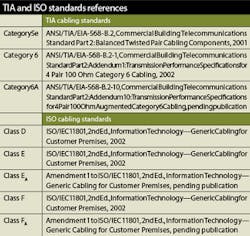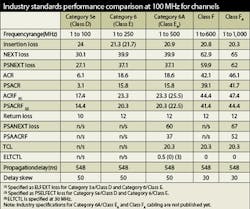From Category 5e to Class F: De-mystifying cabling specs
by Valeri Rybinski
While the technical requirements of TIA and ISO standards are similar for various grades of cabling, knowing the terminology details is key to understanding performance.
When faced with the daunting task of upgrading an existing network or designing a new building facility, it’s important that you look to industry standards for guidance on performance and lifecycle considerations. But while the technical requirements of the Telecommunications Industry Association (TIA; www.tiaonline.org) and International Standard for Organization (ISO; www.iso.org) are very similar for various grades of cabling, the terminology for the level of performance within each committee’s standards can cause confusion.
This article will help you de-mystify the various cabling specifications and their terminologies that are key to designing to the performance you require.
The TIA and ISO committees are the leaders in the development of structured cabling standards. Committee members work hand-in-hand with applications development committees to ensure that new grades of cabling will support the latest innovations in signal transmission technology. TIA standards are often specified by North American end-users, while ISO standards are more commonly referred to in the global marketplace.
These structured cabling standards specify generic installation and design topologies that are characterized by a “category” or “class” of transmission performance. The cabling standards are subsequently referenced in applications standards, developed by committees, such as IEEE and ATM, as a minimum level of performance necessary to ensure application operation. There are many advantages to be realized by specifying standards-compliant structured cabling, including the assurance of applications operation, the flexibility of cable and connectivity choices that are backward compatible and interoperable, and a structured cabling design and topology that is universally recognized by cabling professionals responsible for managing cabling additions, upgrades, and changes.
Same tune, different notes
In addition to TIA and ISO, there are often regional cabling standards groups, such as JSA/JSI (Japanese Standards Association), CSA (Canadian Standards Association), and CENELEC (European Committee for Electrotechnical Standardization) developing local specifications. These regional cabling standards groups contribute actively to their country’s ISO technical advisory committees, and the contents of their standards are usually very much in harmony with TIA and ISO requirements.
But there can be slight variations in terminology. In TIA standards, for example, cabling components (e.g., cables, connecting hardware, and patch cords) are characterized by a performance “category” and are mated to form a permanent link or channel that is also described by a performance “category”. In ISO, components are characterized by a performance “category,” while permanent links and channels are described by a performance “class”.
TIA and ISO equivalent grades of performance are characterized by their frequency bandwidth, and are shown in the table, “TIA and ISO equivalent classifications” (above).
Both TIA and ISO state that the cabling systems specified in their standards are intended to have a useful life in excess of 10 years. Since applications, such as Ethernet, typically have a useful life of five years, it is recommended practice to specify cabling systems that will support two generations of network applications. For most commercial building end-users, this means specifying a cabling plant that is capable of supporting 1000Base-T (Gigabit Ethernet) today and a planned upgrade to 10GBase-T in five years.
Structured cabling guidelines
TIA categories and ISO classes of structured cabling that are recognized for the support of data-speed applications are specified in the table, “TIA and ISO standards references” (right).
Although the Category 6A, Class EA, and Class FA standards are not yet published, the draft requirements have remained unchanged through several industry ballot cycles and are considered by cabling experts to be firm. Standards for these categories/classes are expected to be approved for publication within the next six months, and are commonly specified in new commercial building cabling designs.
To help bring clarity to your structured cabling performance needs for your network upgrade or new install, here’s a brief overview of the TIA categories and ISO classes:
Category 5e/Class D. These cabling requirements were first published in 2000 to address the additional transmission performance characterization required by such applications as 1000Base-T that utilize bi‑directional and full four-pair transmission schemes. The standard added headroom to Category 5 performance limits and characterized several new transmission criteria that were required for support of Gigabit Ethernet over a worst case, four-connector channel. (The 1000Base-T application was originally targeted for operation over Category 5 channels having just two connectors.) To ensure that additional performance margins were satisfied, Category 5e/Class D specifications added headroom to the parameters of NEXT loss, ELFEXT loss, and return loss, and introduced the characterization of crosstalk using power summation, which approximates the total crosstalk present when all pairs are energized as in a four‑pair transmission scheme.
Although no longer recognized by TIA/ISO standards for new installations, a substantial number of installed Category 5 channels are likely to support the 1000Base-T application. Information on the qualification of legacy Category 5 installations for this application can be found in annex D of ANSI/TIA/EIA‑568‑B.2.
Category 6/Class E. The majority of structured cabling specified for new buildings in the past five years has been Category 6/Class E-rated because it provided the maximum performance headroom and return-on-investment. Category 6/Class E cabling delivered double the signal-to noise margin (attenuation-to-crosstalk margin is positive to 200 MHz) of Category 5e/Class D cabling, and provided the performance headroom desired by end users to ensure that their cabling plant could withstand the rigors of the cabling environment and still support 1000Base-T when it was time for an upgrade.
The Category 6/Class E cabling specification development process also brought to light the need to limit the conversion of differential mode signals to common mode signals (and vice versa) through the characterization of component balance, resulting in cabling systems with improved electromagnetic compatibility (EMC) performance.
Although, Category 6/Class E cabling was primarily targeted to support 100Base-T and 1000Base-T applications, some of the installed base of Category 6/Class E cabling can also support the 10GBase-T. The newly published TIA TSB-155 and ISO/IEC 24750 technical bulletins identify the additional performance headroom, as well as applicable field qualification test requirements and procedures that must be satisfied by the installed base of Category 6/Class E cabling to support 10GBase-T.
Since the digital signal processing (DSP) capabilities of 10GBase-T result in full internal pair-to-pair crosstalk cancellation, this application is particularly sensitive to undesired signal coupling (alien crosstalk) between adjacent components and cabling. The characterization of alien crosstalk in the installed Category 6/Class E cabling plant is the main focus of the TIA TSB-155 and ISO/IEC 24750 technical bulletins.
Because the alien crosstalk in Category 6/Class E UTP cabling is dependent upon installation practices (e.g., bundling, use of tie-wraps, pathway fill), performance values were developed based upon a “typical” worst case environment. This means that 10GBase-T should operate over Category 6/Class E UTP channel lengths of up to 37 meters, and may operate over channel lengths of 37 to 55 meters of Category 6/Class E UTP cabling depending upon the actual alien crosstalk levels present. Since the overall foil in Category 6/Class E F/UTP (foiled unshielded twisted-pair) cabling designs significantly reduces alien crosstalk, these length limitations are not applicable to F/UTP cabling.
TIA TSB-155 and ISO/IEC 24750 also specify recommended mitigation practices should an installed Category 6/Class E channel not satisfy the minimum alien crosstalk levels. Mitigation techniques include using non-adjacent patch panel ports to support the 10GBase-T application, separating or using improved equipment cords, using F/UTP equipment cords, unbundling cables, reconfiguring cross-connects as interconnects, and replacing Category 6/Class E components with Category 6A/Class EA components.
Category 6/Class E cabling is not recommended for new installations targeted for support of the 10GBase-T application because while field test devices for determining compliance to the new PSANEXT loss and PSAACRF (previously known as PSAELFEXT loss) parameters are just now being introduced to the market, the test methodology remains extremely time-consuming, overly onerous to implement, and may not be fully conclusive. Furthermore, in a majority of installations, alien crosstalk mitigation will be required. Often, the recognized mitigation methods cannot be easily implemented due to existing pathway fill restrictions and the potential for replacing components. In addition, there is no guidance on qualification procedures for large installations or future moves/adds/changes (MACs).
Since the Category 6/Class E standard was published in 2002, it is at the halfway point of its targeted 10‑year lifecycle. Cabling specifiers are now looking to even higher performing grades of cabling to ensure maximum performance and return-on-investment.
Category 6A/Class EA. Category 6A/Class EA cabling requirements are nearing finalization and were initially developed to address the extended frequency bandwidth and alien crosstalk headroom required to support 10GBase‑T over 100 meters of cabling containing up to four connectors. Category 6A/Class EA cabling delivers positive signal-to-alien crosstalk margin up to 500 MHz, and is recommended as the minimum grade of cabling capable of withstanding the rigors of the cabling environment as well as supporting 10GBase-T when it is time for an upgrade. For the first time, balance requirements for channels and permanent links are also specified, thereby ensuring better EMC performance than any previous generation of cabling.
Performance headroom has been incorporated into all transmission parameters, including power sum alien crosstalk. In addition, both laboratory and field test qualification methods are specified. Average power sum alien crosstalk across all four pairs is specified for use by the IEEE committee in their channel capacity modeling.
Note that the term “equal level far-end crosstalk loss” (or ELFEXT loss) previously used in TIA specifications has been replaced by “attenuation to crosstalk ratio, far-end” (or ACRF). The intent of this change is for TIA to harmonize with the ISO terminology and more accurately describe the actual test measurement configuration.
Category 6A/Class EA cabling can provide the maximum return-on-investment when the calculations are performed using a 10-year lifecycle.
Class F. Published in 2002 and describing performance criteria for a fully shielded media type (i.e., cabling with an overall shield and individually shielded pairs), Class F (aka, Category 7) cabling delivers positive attenuation-to-crosstalk margin up to 600 MHz and offers unsurpassed EMC performance because of its shielded construction.
Although the TIA is not actively developing a standard for Category 7, it is acceptable to specify Class F cabling in North American markets. The rationale is that, in addition to being recognized by BICSI, NEMA, IEEE, and other standards organizations, Class F is simply a superset of TIA Category 6A requirements. Field test requirements and adapters for Class F cabling qualification have been commercially available since 2002.
The non-RJ style plug and socket interface specified in IEC 61076-3-104:2002 is the most commonly specified Category 7 connector, due to its ease of use, performance headroom, ability to support multiple applications under one sheath, and its specification as the recommended Category 7 interface in the ISO 15018 Standard. This interface is commercially available from multiple manufacturers whose products are interoperable, and cabling industry and applications developers appear ready to adopt fully-shielded cabling. For example, Class F cabling was identified as the copper media-of-choice in one IEEE new application call-for-interest, while the published ISO/IEC 14165‑114 application Standard-A Full Duplex Ethernet Physical Layer Specification for 1,000 Mbit/s operating over balanced channels Class F (Category 7 twisted pair cabling)-specifies operation over a minimally rated Class F channel.
The advantage that Class F has over other grades of cabling is that it is targeted for support of next-generation applications beyond 10GBase‑T. Class F cabling is the only media to have a 15‑year lifecycle, and can provide the maximum return-on-investment when calculations are performed using a 15-year lifecycle.
Class FA. Requirements are under development and are based upon the existing Class F cabling requirements and Category 7 non-RJ style plug and socket interface. The significant enhancement in Class FA specifications is the extension of the frequency bandwidth of characterization from 600 MHz to 1,000 MHz, making the cable uniquely capable of supporting all channels of broadband video that operate up to 862 MHz. All fully-shielded cabling solutions specified in the near future likely will be Class FA.
The table, “Applications chart” (page 56), summarizes cabling types capable of supporting commonly specified applications over 100‑meter, four-connector topologies.
The table, “Industry standards performance comparison at 100 MHz for channels” (page 58), provides data for Category 5e/Class D, Category 6/ClassE, Category 6A/Class EA, Class F, and Class FA channels. Where there is a slight difference between TIA and ISO performance limits, ISO performance limits are indicated in parenthesis.
Foundation building
When designing and installing structured cabling systems, it’s important that you choose the strongest foundation to support your present and future network applications needs. To ensure support of emerging technologies that use the latest advances in signaling schemes, it is also critical to be as informed as possible.
You can trust the TIA and ISO standards developmental groups to specify complete cabling criteria capable of providing applications assurance for tomorrow’s technologies today.
(TIA and ISO standards are copyright-protected. Copies can be purchased online through IHS Global Engineering Documents [www.global.ihs.com].)VALERIE RYBINSKI is global sales engineer with Siemon (www.siemon.com).





